Download CBSE Class 8 Science Sound Notes in PDF format. All Revision notes for Class 8 Science have been designed as per the latest syllabus and updated chapters given in your textbook for Science in Class 8. Our teachers have designed these concept notes for the benefit of Class 8 students. You should use these chapter wise notes for revision on daily basis. These study notes can also be used for learning each chapter and its important and difficult topics or revision just before your exams to help you get better scores in upcoming examinations, You can also use Printable notes for Class 8 Science for faster revision of difficult topics and get higher rank. After reading these notes also refer to MCQ questions for Class 8 Science given on studiestoday
Revision Notes for Class 8 Science Chapter 13 Sound
Class 8 Science students should refer to the following concepts and notes for Chapter 13 Sound in Class 8. These exam notes for Class 8 Science will be very useful for upcoming class tests and examinations and help you to score good marks
Chapter 13 Sound Notes Class 8 Science
CBSE Class 8 Science Sound Chapter Notes. Learning the important concepts is very important for every student to get better marks in examinations. The concepts should be clear which will help in faster learning. The attached concepts made as per NCERT and CBSE pattern will help the student to understand the chapter and score better marks in the examinations.
SOUND
Sound is a form of energy which produces the sensation of hearing in our ear's.
HOW SOUND IS PRODUCED
The following activities will help you understand how sound is produced.
ACTIVITY
Place a metallic/plastic ruler on the table. Take care to place it in such a way that 2/3rds of the scale projects (just out) from the edge of the table. Place a heavy object such as a dictionary or a brick on the ruler. Now press the projecting end downwards and release it abruptly. What do you observe?
You wil see that the ruler snaps back and starts vibrating. At the same time, it also produces a sound. Once the vibrations stop, the sound also stops.
Vibrating Bodies Produce Sound
Cut a rubber band. Hold one end of it in your mouth and the other end in your hand and stretch it. Now, pull it with the other hand and release it (fig). What happens to the rubber band? You will notice that it moves to and fro or vibrates and it also produces sound.
Sound from a Vibrating Blade
Take a used shaving blade and fix it on a table, or desk as shown in Fig. Bend the upper end of the blade and leave it. The blade begins to vibrate. You can actually see it vibrating. Touch the blade carefully with your finger. It stops vibrating. Does it produce any sound now?
Conclusion : From these activities, we come to the conclusion that the sound is produced by the vibrating objects or bodies.
Characteristic of Vibrations : In sound producing objects, the vibrations take place very fast...so fast, in fact, that they cannot be seen very clearly with the unaided human eye (slow-motion video is one practical solution that is routinely used in scientific and industrial applications). We can produce slower vibrations, which are also called oscillations, by an arangement called a simple pendulum. It consists of a ball or any weight, such as a stone, wooden top, steel bolt, etc. which is here called a bob, and which hangs down vertically.
Figures show a oscillating simple pendulum and a vibrating string depicting the mean position and amplitude. by means of a thread. It hangs vertically because of the force of gravity acting upon it. When the bob is given a small push, it performs a to-and-fro motion for some time and ultimately stops. The position where the bob stops is called the mean position (A) or the equilibrium position.
AMPLITUDE
The maximum displacement of the bob from the mean position during oscilations is called amplitude of the oscillation. In the case of a simple pendulum, as show in the figure, the amplitude is AB (or AC).
FREQUENCY
The number of oscillations produced by the vibrating body in one second is called its frequency. It is denoted by the letter 'f'. The unit of frequency in SI
system is Hertz (Hz or s–1). When a vibrating body produces 10 vibrations (oscillations) in one second, its frequency is said to be 10 hertz.
If the frequency of a tuning fork is written as 200 Hz, it means that it produces 200 vibrations in one second.
TIME PERIOD
When a bob moves from one position and returns to the same position, such that it repeats the motion, it is said to complete on oscillation.
The time taken by a vibrating body to complete one oscilation is called the time period.
TRY YOUR SELF
Q. Define vibrations Q. How is sound produced?
Q. What is meant by oscillatory motion? Q. Define frequency.
Q. Give the unit in which frequency is measured.
Q. The sound from a housefly is produced when it vibrates its wings at an average rate of 300 vibrations per second. What is the time period of the vibration?
Q. The frequency of a given sound is 4.5 kHz. how many vibrations is it completing in one second?
REQUIREMENTS FOR SOUND
To produce sound by vibrations, a mechanical device (the source) must first receive an input of energy. Next, the device must be in contact with a medium that will receive the sound energy and carry it to a receiver. If the device is not in contact with a medium, the energy will not be transferred to a receiver, and there will be no sound. Thus, three basic elements for transmission and reception of sound must be present before a sound can be produced they are (1) the source (or transmitter), (2) a medium for carrying the sound (air, water, metal, etc.), and (3) the detector (or receiver).
COMPETITIVE WINDOW
TYPES OF WAVES
On the basis of the need of medium, waves are of two types :
(a) Mechanical wave (b) Electromagnetic wave
(a) Mechanical Wave : A machanical wave is a periodic distrubance which requires a material medium for its propagation. The properties of these waves depend upon the medium so they are known as elastic waves, such as sound waves, water waves, waves in stretched string. On the basis of motion of particles the mechanical waves are classified into two parts :
(i) transverse wave (ii) Longitudinal wave
(i) Transverse wave : A wave motion in which the particles of the medium oscillate about their mean positions at right angles to the direction of propagation of the wave is called transverse wave. These waves can propagate through solids and liquids but not through gases because gases do not possess elastic properties.
E.g. – Vibration in strings, ripple on water surface etc. These waves travel in the form of crests and
troughs.
(ii) Longitudinal wave : A wave motion in which the particles of the medium oscillate about their mean position is the direction of propagation of wave, is called longitudinal wave. These waves can propagate through solids, liquids and gases.
E.g. – Wave produced by compressing a spring, sound waves etc. They travel in the form of compressions and rarefactions.
(b) Electromagnatic waves : Electromagnetic wave is a periodic distrubance which does not require any material medium for its propagation and can travel even through vacuum.
E.g. – Light waves, X-ray and radio waves etc. These waves are of transverse type.
PROPAGATION OF SOUND
Unlike light, sound can travel only through a material medium. Hence a material medium is necessary for the propagation of sound. Let us do some activities to prove that sound can travel through solid, liquids and gases.
ACTIVITY
Sound Travels Through Solids
Take a wooden stick and press your ear at one end of it. Ask a friend to gently knock at the other end (fig). You will be able to hear the sound very clearly. This shows that sound can travel through solids.
Sound Travels Through Liquids
Place a squeaking toy in a polythene bag and hold it in a bucket of water (Fig). Can you hear its squeak, when you squeeze it? Place your ear against the side of the bucket and squeeze the toy again. Do you hear its squeak? In which case did you hear the sound better? This activity shows that sound can travel through liquids as well.
Sound Travels Through Gases
Fill a balloon with air and press it to your ear scretch the other end of it with your fingers (Fig). You will note that the sound reaches your ear. This activity shows that sound can also travel through gases.
SOUND CAN NOT TRAVEL IN VACUUM
A medium is needed for sound to travel. It can travel through any medium – solids, liquids and gases, but not in vacuum. Let us perform the following activity.
ACTIVITY
No movement in Vacuum
Take a bell jar and in it fit an electric bell through an air tight cork as shown in Fig. Place the bell jar on the platform of the vacuum pump and apply a little grease at its edges, so as to make it air tight. Connect the bell to a battery through a key (push button switch). Press the key. You will be able to hear the sound of the bell, as its hammer strikes against the gong.
Now start the vacuum pump. It will be observed that as the air is withdrawn from the bell jar, the loudness of sound of the bell decreases. Furthermore, when a vacuum is created, no sound is heard, in spite of the fact that the hammer is striking against the gong.
Stop the vacuum pump and allow the air to enter the bell jar. The sound of the bell is heard again. This experiment proves:
(i) Sound cannot travel through vacuum
(ii) A material medium is necessary for the propagation of sound.
SPEED OF SOUND
Sound waves travel at different speeds in different substances. The speed of sound varies, depending on factors such as temperature, nature of material, physical state of the substance, etc. For example, the speed of sound in air at 20°C is about 340 m/s, but drops to about 330 m/s 0°C. Sound travels fastest in solids and slowest in gases. Sound does not travel in vacuum.
ABSORPTION OF SOUND
It has been found that shining objects like mirrors, metals or hard objects like buildings or stones reflect sound. However, materials with loose texture absorb sound. For example, curtains; gunny bags; straw; carpets; etc., absorb sound. Big cinema halls or auditoriums are carpeted and their walls are coated with some rough materials, so that they do not reflect any sound. It is because, such places are very big and therefore, echoes are formed. Thus, the quality of sound heard by people becomes poor.
However, in ordinary rooms in which we live, we do not have this problem. It is because they are seldom 11 m or more long or wide. Thus, the original sound and reflected sound reach the ears at almost the same time and hence, no echo is formed.
CHARACTERISTICS OF A SOUND
(a) Loudness : When the string is plucked softly, it produces a feeble sound and when it is plucked hard, it produces a ouder sound. In other words, in the first case vibrations with small amplitudes are produced and in the second case vibrations with large amplitudes are produced.
This means that the loudness of a sound depends on the amplitude of vibration. It is measured in decibels (dB).
(b) Pitch : The shrillness or flatness of a sound is known as pitch. We can distinguish between a man's voice and woman's voice of the same loudness without even seeing whether the speaker is a man or a woman. A man's voice is flat and has a low pitch, Whereas a woman's voice shrill and has a high pitch. The pitch of a sound depends on the frequency of vibration. The higher the frequency of a sound, the higher will be its pitch.
In other words, high pitched sounds (such as the shrill whistling of a kettle or a jet engine) are created at high frequencies. This is obviously why we whistle for our dog; the high pitched sound attracts him. You can get a special 'dog whistle' that emits a very high pitched sound at a frequency much beyond 20,000 Hz; humans cannot hear it, but your dog will come bounding up to you when he hears the sound (inaudible to you)!
(c) Quality or Timber : The characteristic of sound which enables us to distinguish between two sounds of the same pitch and loudness, produced by two diferent sources is called its quality or timber. For example, we can recognise a person by hearing his voice, we can also distinguish the sound of a guitar from that of a sitar or harmonium.

HOW WE HEAR SOUND THROUGH OUR EARS
Human Ear : We have learnt that vibrating objects produce sound which is carried in all directions in a medium. How do we hear sound? Our ears help us to hear sound. Human ear has three important parts. Only one of its parts can be seen and felt by you, which is the outer ear. The rest of the ear remains deep inside the skull.
(i) Outer Ear : The outer ear consists of the pinna and the eartube. The shape of the outer part of the ear is like a funnel. When sound enters the ear, it travels down a canal at the end of which a thin membrane is stretched tightly.
This tightly stretched membrane is called the eardrum, which performs a very important function.
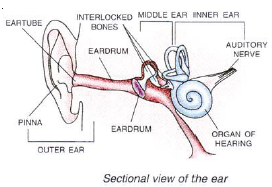
(ii) Middle Ear : It has three very tiny interlocked bones. The innermost bone is joined to the inner ear.
(iii) Inner Ear : It has a coiled organ of hearing semicircular canals and the auditory nerve.
A vibrating body caues air molecules to vibrate. These vibrations reach out ear and are collected by the pinna and then funnelled into the ear tube. These vibrations stricke the eardrum that start vibrating with the same frequency. It then forces the interlocked bones to vibrate. The hearing organ passes the vibrations to the auditory nerve, which takes the signal to the brain. This enables us to hear the sound.
SOUND PRODUCED BY HUMANS
In a human being, sound is produced by a voice box (larynx). Two vocal cords are stretched across the voice box such that a passage for air remain between the cords. When we speak lungs force air through the passage due to which the cords start vibrating and produce sound. The tightness of the cords are controlled by the muscles connected to vocal cords.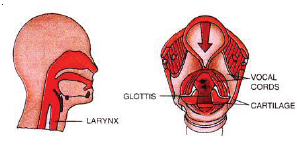
LISTENING OF SOUND BY HUMANS
The ear has a stretched membrane called ear drum or tymphanic membrane. When sound reaches our ear it strikes the ear drum which starts vibrating. These vibrations are carried forward into the ear by a connection of bones (hammer, anvil and stirup). These are then converted into electrical signals which are interpreted by the brain.
AUDIBLE AND INAUDIBLE SOUND
It has been proved that the human ear is not sensitive to vibrations of all frequencies. In other words, we can only hear sounds that fall within a certain range of frequencies; any sound outside that frequency range is inaudible to our ears. We can hear sounds within frequencies ranging from 20 Hz to 20,000 Hz. This is called Audible frequency range of sound. Such vibrations are called sonic vibrations or sound vibrations.
Sound frequencies less than 20 Hz are called Infrasonic sound and sound frequencies more than 20,000 Hz (20 k Hz) are called Ultrasonic sound. Human beings cannot perceive either infrasonic or ultrasonic sounds.
Hence, these are called 'Inaudible' sounds, i.e., sounds we cannot hear. Dogs, on the other hand, have much 'sharper' hearing, since they can hear sounds within the frequency range of 50 Hz to 45000 Hz ! That is why your dog starts braking a welcome long before you have reached your front door; he has heard your footfalls or recognised the distinctive sound of your car as it enters the gate. Almost all animals have a wide range of hearing. Bats can detect frequencies as high as 100,000 Hz!
SOUND PRODUCED BY ANIMALS
Most mammals such as dogs, cows, cats, etc. produce sound with the help of their vocal cords. Dogs can be easily trained to respond to a whistle which generates ultrasonic vibrations and is commonly called Galton's whistle.
Birds produce sound by means of a ring of cartilage called Syrinx, fixed at the beginning of their winds pipe. Some birds have two parts in the syrinx. Thus, they can produce two different notes. Insects such as bees, houseflies, mosquitoes produce buzzing sound by rapidly flapping their wings. Dolphins are related to the whale family. They use ultrasonic sound to locate their prey.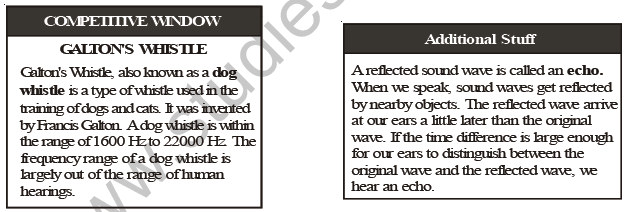
USES OF ULTRASONIC VIBRATIONS BY ANIMALS
1. Dogs can hear upto the frequency of 40,000 Hz as compared to humans who can hear upto 20,000 Hz. Dogs can be specially trained to respond to a whistle which produces ultrasonic vibrations and is commonly called Galton whistle. The sound of this whistle cannot be heard by humans.
2. Bats produce vibrations in the frequency range of 50 Hz to 80,000 Hz. Bats have very weak eyes. When the bats fly at night, they produce ultrasonic vibrations which cannot be heard by the humans or the insects. When these vibrations strike the insects, they are reflected back. On receiving the reflected sound, the bat can locate the insect and eat it.
3. Dolphins are related to the whale family. They use ultrasonic sound to locate their prey, in much the same way as the bats.
USE OF ULTRASONIC VIBRATIONS IN INDUSTRY
1. Ultrasonic vibrations are used for homogenising milk, i.e., the milk is agitated with ultrasonic vibrators. These vibrations break down the larger particles of the fat present in milk to smaller particles.
2. Ultrasonic vibrations are used in dish washing machines. In such machines, water and detergent are vibrated with ultrasonic vibrators. The vibrating detergent particles rub against the dirty utensils and thus clean them.
3. Ultrasonic vibrations produce a sort of depression in rats and cockroaches. Ultrasonic vibrators are used to drive rats and cockroaches from godowns.
4. Ultrasonic vibrations are used for imaging internal organs of human body. In fact they are even used to study the growth of foetus in mother's womb.
5. Ultrasonic vibrations are used in relieving pain in joints and muscles.
6. Ultrasonic vibrations are used in detecting flaws in articles made from metals. They are also used in finding the thickness of various parts of a metallic component.
NOISE AND MUSIC
A sound which does not have a pleasing sensation on the ears is called noise. Scientifically, a noise is produced by irregular vibrations. Conversely, a sound which has a pleasant sensation on the ears is called music.
Scientifically, a musical sound is produced by regular vibrations. For example, the prong of a tuning fork or the string of a sitar vibrates at regular intervals and hence, they produce musical sound.
MEASURE OF LOUDNESS OF SOUND
The loudness of sound is measured in decibels (dB). It signifies the sound pressure level. Human ears can pick up sound from 10 dB to 180 dB. The loudness of sound is considered normal, if it is between 50 dB to 60 dB. A normal human being can tolerate loudness of 80 dB. The sound above 80 dB is painful and causes various health problems. The table given below gives the loudness of various sounds in decibels and their effect on human ear.
NOISE POLLUTION
The disturbance produced in the environment by undesirable, loud and harsh sound from various sources is called noise pollution.
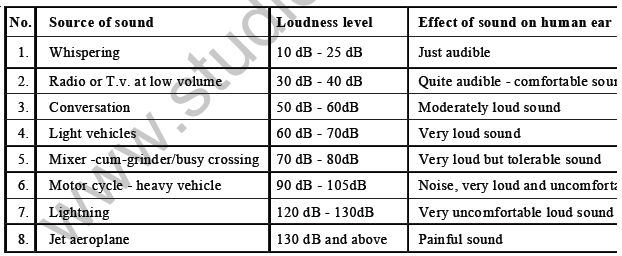
Noise pollution is a recent phenomenon of twentieth century. Increasing dependence of the man on various kinds of machines at home, or work place or factories, etc., has contributed a lot to the noise pollution.
The noise pollution at a particular place is determined by following factors :
(i) Loudness of the sound (ii) Duration of noise.
SOURCE OF NOISE
1. Noise in homes: Following are the causes of noise in homes. (i) television, (ii) radio, (iii) power music system, (iv) washing machines, (v) desert cooler, (vi) mixer-cum-grinder, (vii) vacuum cleaner, (viii) telephone, (ix) typewriter, (x) air conditioner.
2. Noise in surroundings: Following are the causes of noise in surroundings: (i) loud speakers used in marriages and religious places, (ii) exploding crackers on various functions, (iii) hawkers in the street, (iv) publicity announcements made by trading companies, (v) noise produced in the construction of houses, etc.
3. Noise in factories: All factories, big or small use machines, which invariably produce noise and hence contribute to noise pollution.
4. Noise due to transportation : This noise is produced by (i) trains, (ii) all kinds of petrol and diesel vehicles, (iii) aeroplanes, (iv) pressure horns used in automobiles.
HARMFUL EFFECTS OF NOISE POLLUTION
1. Noise in the surroundings interferes with conversation with another person.
2. A long exposure, to noise pollution may result in the loss of hearing.
3. Noise pollution reduces concentration and results in the loss of work efficiency.
4. Noise causes anger, tension and interferes with the sleep pattern of individuals.
5. Noise produces headaches, irritability and nervous tension.
6. Noise can cause loss of night vision as well as cause colour blindness.
PREVENTION AND CONTROL OF NOISE
In the modem society we cannot eliminate noise, but can lower its level to bearable limits by taking following measures :
1. The machines should be designed in such a way that they produce minimum noise.
2. All automobiles, electric generators, etc., should be provided with improved silencers.
3. The heavy vehicles should not be allowed in residential areas.
4. The use of loudspeakers for various social or religious functions should be banned.
5. The factories should be relocated far away from the residential areas.
6. At homes, T.V, radio, power music system, should be played at low volume.
SOUNDS PRODUCED BY MUSICAL INSTRUMENTS
There are basically three families of musical instruments:
(a) STRINGED INSTRUMENTS (TANTU VADYA)
Stringed instruments have taut strings mounted over specially designed wooden frames, which are partially hollow from within.
When the strings are plucked or struck or played with a bow they vibrate to produce a musical sound of some particular frequency. The pitch of the sound of a musical instrument can be changed by altering its length.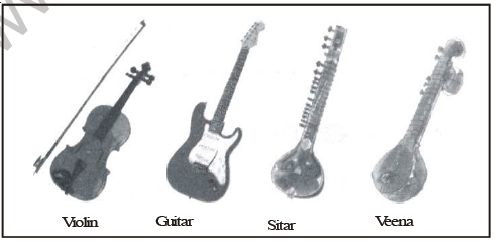
(b) WIND OR REED INSTRUMENTS (SUSHIR VADYA)
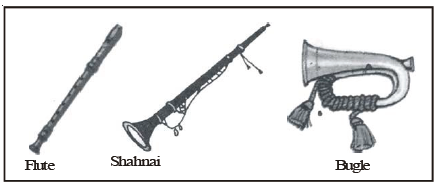
Wind instruments make use of vibrating air columns. In these instruments, the air is blown in, either directly or through the reeds. Flute, Shahnai, Bag pipes, Bugles, etc., are some of the examples of wind instruments.
(c) PERCUSSION OR MEMBRANE INSTRUMENTS (AVANADDHU VADYA)
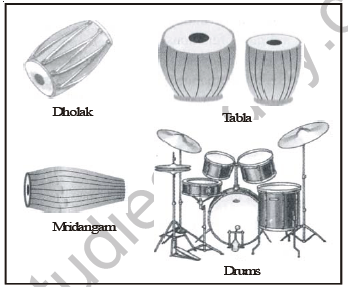
All percussion instruments have a taut skin over a hollow metal or wooden frame. When the skin is struck, it produces a musical sound. Dholak, tabla, mridangam and drums, etc., are some of the examples of percussion instruments.
There are some other musical instruments which are exclusively used in our country, but.do not belong to any of the above three kinds of musical instruments. They can be placed in a fourth class of musical instruments.
(d) GHANA VADYA
These instruments are simply beaten or struck in a rhythm.
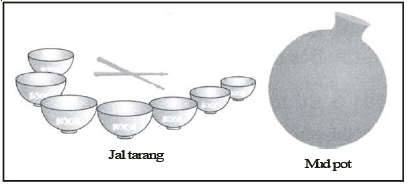
Manjira (cymbals), the ghatam (mud pots), jal tarang, etc., are some of the Ghana Vadya. These instruments are commonly used in all parts of our country.
COMPETITIVE WINDOW
SONAR
SONAR stands for Sound Navigation and Ranging.
It is a device which is used in the ships to locate rocks, icebergs, submarines, old ships sank in sea ete. It is also used to measure the depth of a sea.
PRINCIPLE
It is based on the principle of the reflection of sound wave (i.e. echo).
Determination of the Depth of a Sea using Sonar A beam of ultrasonic waves from the transmitter of a SONAR fitted on the ship is sent towards the bottom of the sea. This beam is reflected back from the bottom of the sea and is received by the receiver of the SONAR on the ship.
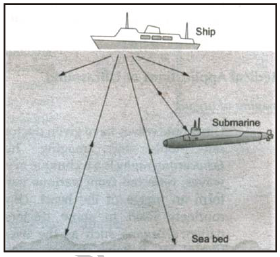
The time taken by the ultrasonic waves to go from the ship to the bottom of the sea and then back to the ship is noted.
Let it be 't' seconds. Therefore, the time taken by the ultrasonic waves to go from the ship to the bottom of the sea is (t/2) seconds.
Using the following formula S = v(t/2) . we can find the depth of the sea.
Here, u = speed of ultrasonic wave in water.
S = depth of the sea
Q. A ship sends on a high frequency sound wave and receives an echo after 1 second. What is the depth of the sea? Speed of sound in water is 1500 m/ s.
Sol. Let,
Depth of the sea = d
So, Total distance travelled by the sound wave = 2d
Time taken by sound to travel both ways = 1 s
As per definition,
Speed of the sound = Total distance travelled/Time taken
Then, 1500 m s–1 = 2d/1s
or d =
1500ms–1 × 1s/2 = 750 m
hus the depth of the sea is 750 metres.
Q. A sonar echo takes 2.2 s to return from a whale. How far away is the whale?
Sol. Total time taken by the signal = 2.2 s
So, Time taken the signal to reach the whale = 2.2 s/2 = 1.1 s
Distance of the whale = d ?
From the literature, speed of sound in sea water at 25°C = 1533 m s–1
So, Distance of the whale, d = Speed of the signal x Time taken or d = 1533 m s–1 × 1.1 s = 1686.3 m
TICK THE CORRECT OPTION
Question. Sound is produced by ___
(A) Oscillation
(B) Vibration
(C) Compression
(D) Combination
Answer: B
Question. Sound is a form of ___ that produces the sensation of hearing in our ears.
(A) Heat
(B) Gas
(C) Energy
(D) Speed
Answer: C
Question. The vibrations started at a point from the source are transmitted in the ___ from that point to the nex and so on :
(A) Circle
(B) Straightline
(C) Sphere
(D) Medium
Answer: B
Question. Vibrations travel in all directions and produce compressions and ___ in the medium.
(A) Transformation
(B) Rarefactions
(C) Polarisation
(D) Deformation
Answer: B
Question. One complete ___ motion of the body is called one vibration.
(A) Circular
(B) Linear
(C) Forward
(D) To and fro
Answer: D
Question. The maximum displacement of a vibrating body from its rest or mean position is called its ___
(A) Time period
(B) Vibration
(C) Frequency
(D) Ampitude
Answer: D
Question. The amplitude of the vibrating strip is measured in ___
(A) Metre
(B) Centimetre
(C) Millimetre
(D) Decimetre
Answer: A
Question. The time taken by a vibrating body to complete one vibration is called its ___
(A) Frequency
(B) Ampitude
(C) Time period
(D) Vibration
Answer: A
Question. The number of complete vibrations that the vibrating body makes in one second is called its ___
(A) Ampitude
(B) Vibration
(C) Time period
(D) Frequency
Answer: C
Question. The frequency of sound produced by a vibrating body is ___ to the frequency of the vibrating body.
(A) Greater
(B) Lesser
(C) Equal
(D) Partial
Answer: A
Question. Frequency is measured in ___
(A) Amperes
(B) Coloumbs
(C) Hertz
(D) Kelvin
Answer: C
Question. Human beings cannot hear sound of frequencies below ___
(A) 15 Hz
(B) 10 Hz
(C) 20 Hz
(D) 30 Hz
Answer: B
Question. The range of frequencies from ___ is called the audible range.
(A) 20 Hz to 20,000 Hz
(B) 10 Hz to 10,000 Hz
(C) 30 Hz to 30,000 Hz
(D) 40 Hz to 40,000 Hz
Answer: A
Question. Sounds of frequency higher than 20,000 Hz are called ___
(A) Panasonic
(B) Ultrasonic
(C) Subsonics
(D) Supersonic
Answer: B
Question. The sound of frequency lower than 20 Hz are called the ___
(A) Infrasonics
(B) Supersonic
(C) Panasonic
(D) Ultrasonic
Answer: A
Question. The infronic sound is used successfully in drilling deepest wells because the ___ vibrations break up hard rock more easily than the ordinary drill do.
(A) Low frequency
(B) Medium frequency
(C) Unequal frequency
(D) High frequency
Answer: D
Question. The speed of sound depends on the elasticity E of medium and the ___ of the medium.
(A) Plasticity
(B) Friction
(C) Position
(D) Density
Answer: D
Question. The speed of sound is ___ in different media.
(A) Negligible
(B) Equal
(C) Differnet
(D) Minute
Answer: C
Question. The speed of sound does not depend on the ___ and the amplitude of the wave.
(A) Height
(B) Wavelength
(C) Thickness
(D) Length
Answer: B
Question. The speed of sound in air is independent of ___
(A) Density
(B) Temperature
(C) Pressure
(D) Frequency
Answer: B
Question. Te sound heard after reflection from a rigid obstacle is called the ___
(A) Refleciton
(B) Refraction
(C) Deflecltion
(D) Echo
Answer: D
Question. To hear the echo of a sound distinctly, the reflecting surface should be at a minimum distance of ___ from the observer.
(A) 15.5 m
(B) 16.6 m
(C) 11.2 m
(D) 18.6 m
Answer: C
Question. Speed of sound at constant temperature depends on :
(A) Pressure
(B) Density of gas
(C) Above both
(D) None of these
Answer: D
Question. Echo is a type of :
(A) Reflected sound
(B) Refracted sound
(C) Polarised sound
(D) None of these
Answer: A
Question. One hertz is equivalent to :
(A) One cycle per second
(B) One second
(C) One metre per second
(D) One second per metre
Answer: A
Question. The speed of sound in air at 0°C is approximately :
(A) 332 ms–1
(B) 350 ms–1
(C) 530 ms–1
(D) 332 kms–1
Answer: A
Question. If a pendulum is allowed to oscillate into a jar containing water, its time period will
(A) increase
(B) decrease
(C) remain same
(D) none of these
Answer: A
Question. If a pendulum is allowed to oscillate in vacuum, its time period will
(A) decrease
(B) increase
(C) remain same
(D) none of these
Answer: A
Question. If the mass of a pendulum is doubled, the time period
(A) becomes double
(B) becomes half
(C) becomes 4 times
(D) remains the same
Answer: D
Question. The phenomenon in which the amplitude of oscillation of a pendulum decreases gradually is called
(A) decay period of oscillation
(B) damping
(C) building up of oscillation
(D) maintained oscillation
Answer: B
Question. In which of the following media will sound travel the fastest?
(A) Solid
(B) Both solid and liquid
(C) Liquid
(D) Gas
Answer: A
Question. Sound waves in air are waves.
(A) longitudinal
(B) radio
(C) transverse
(D) electromagnetic
Answer: A
Question. Out of the following, which frequency is not clearly audible to the human ear?
(A) 30 Hz
(B) 30,000 Hz
(C) 300 Hz
(D) 3000 Hz
Answer: D
Question. Sound waves are
(A) transverse mechanical waves
(B) longitudinal mechanical waves
(C) neither (A) nor (B)
(D) none of these
Answer: B
Question. The time period of the above wave would be
(A) 1/30 s
(B) 30 s
(C) 1/24 s
(D) none of these
Answer: A
Question. The relation between frequency (n) and wavelength (λ) is given by (v is velocity, n is frequency and T is timeperiod)
(A) v = nλ
(B) n = v/λ
(C) v = 2n/λ
(D) n =T/λ
Answer: A
Question. A body produces sound only if it is
(A) made of steel
(B) made of glass
(C) plucked
(D) vibrating
Answer: D
Question. A crest is the point of
(A) zero displacement
(B) maximum displacement
(C) minimum displacement
(D) none of these
Answer: B
Question. A trough is a point of
(A) zero displacement
(B) maximum displacement
(C) minimum displacement
(D) none of these
Answer: C
Question. Velocity of sound is maximum in
(A) iron
(B) mercury
(C) water
(D) air
Answer: A
Question. The vibrating body while playing a violin is
(A) wire
(B) the box of the violin
(C) both wire and box
(D) only air
Answer: C
Question. The waves which propagate in metals are
(A) longitudinal
(B) transverse
(C) both (A) and (B)
(D) neither (A) nor (B)
Answer: D
Question. Velocity of sound is minimum in
(A) nitrogen
(B) hydrogen
(C) air
(D) carbon dioxide
Answer: D
Question. The speed of electromagnetic waves in air is
(A) 3 × 105 km/s
(B) 3 × 106 km/s
(C) 3 × 107 km/s
(D) 3 × 108 km/s
Answer: A
Question. Which of the following types of waves is different from others?
(A) waves in the strings of musical instruments
(B) water waves
(C) light waves
(D) sound waves
Answer: D
Question. The SI unit of amplitude of oscillation is
(A) cm
(B) m
(C) km
(D) none of these
Answer: B
Question. Echo is produced due to
(A) reflection of sound
(B) refraction of sound
(C) resonance
(D) none of these
Answer: A
Question. SONAR is based on the principle of
(A) echo
(B) resonance
(C) reverberation
(D) anyone of the above
Answer: A
Question. The audible range of frequency is
(A) 20 Hz to 20,000 Hz
(B) 40 Hz to 40,000 Hz
(C) 60 Hz to 60,000 Hz
(D) 10 Hz to 20,000 Hz
Answer: A
Question. Which of the following frequency of sound can't be heard by human beings?
(A) 40 Hz
(B) 400 Hz
(C) 4000 Hz
(D) 40,000 Hz
Answer: D
Question. The depth of the troughs of a wave is called its
(A) amplitude
(B) displacement
(C) frequency
(D) none of these
Answer: A
Question. The height of the crests of a wave is called its
(A) amplitude
(B) displacement
(C) frequency
(D) none of these
Answer: A
Question. A sound wave is travelling from East to west. In which direction do the molecules in the air move?
(A) East to West
(B) West to East
(C) North to South
(D) South to North
Answer: A
VERY SHORT ANSWER TYPE QUESTIONS
Question. What is the length of vocal cords in men?
Ans. The vocal cords in men are about 20 mm long.
Question. What is meant by oscillatory motion?
Ans. The to and fro motion of an object is known as oscillatory motion.
Question. Define 1 hertz.
Ans. A frequency of 1 hertz meas one oscillation per second.
Question. Define amplitude.
Ans. The maximum distance to which a vibrating body moves on either side of its mean position is called the amplitude of vibration.
Question. How are frequency of a sound and pitch related?
Ans. If the frequency of vibration is higther than the sound has a higher pitch.
Question. Name the equipment which works at frequencies greater than 20,000 Hz.
Ans. Ultrasound equipment.
Question. What is meant by noise pollutoin?
Ans. Presence of excessive or unwanted sound in the atmosphere is called noise pollution.
Question. Name the SI units of (i) time period (ii) frequency.
Ans. (i) Second (ii) Hertz.
Question. What happens to sound when it strikes a surface?
Ans. Sound gets reflected on striking a surface.
Question. Why do we hear the sound of the horn of an approaching can before the car reaches us?
Ans. This happens because the speed of sound is much greater than the speed of the car.
SHORT ANSWER TYPE QUESTIONS
Question. The sound from a mosquito is produced when it vibrates its wings at an average rate of 500 vibrations per second. What is the time period of the vibration?
Ans. Time taken for 500 vibrations = 1 second
Time taken for 1 vibration = 1/500 second
Time period = 1/500 second.
Question. If the amplitude increases 3 times, by how much will the loudness increase?
Ans. If the amplitude increases three times, the loudness will increase by a factor of 9 times.
Question. The frequency of a given sound is 1.5 khz. How many vibrations is it completing in one second?
Ans. Frequency =
No. of vibrations
Time , No. of vibrations = Frequency × Time
= 1.5 × 1000 × 1 = 1500 vibrations
Question. We cannot hear the sound of the exploding meteros in the sky, though we can see then. Why?
Ans. Sound cannot travel through vacuum, In space there is vaccum. Light can travel through vacuum, so we can see the exploding meteor but cannot hear the explosion.
Question. We can hear the supersonic jet planes flying. How?
Ans. The supersonic jet planes fly in the air. Since sound can travel through air, we can hear then flying.
Question. How do birds and insects produce sound?
Ans. Birds chirp with the help syrinx in their wind pipe. Insects produce sound by flapping their wings.
Question. (a) In our body which part of the ear receives sound waves?
(b) What may happen if the ear drum is does not from our ear?
Ans. (a) Pinna helps in receiving sound waves.
(b) If the eardrum is absent we would not be able to hear.
Question. Give an example each of :
(a) Stringed instrument (b) Percussion instrument
(c) Wind instrument (d) Striking instrument
Ans. (a) Violin (b) Drums (c) Flute (d) Jal Tarang
Question. Can sound travel through water? How do whales communicate under water?
Ans. Yes, sound can travel through water. Since sound can travel through water, the whales can communicate with each other.
Question. How is that you can hear a friend talking in another room without seeing him?
Ans. Sound can travel in all directions and around corners. Light cannot travel around corners. Therefore, we can hear a friend talking in another room but cannot see him.
ANSWER THE FOLLOWING IN BRIEF
Question. List sources of noise pollution in your surrounding.
Ans. The major sources of noise pollution are sounds of vehicles, explosions, machines, loudspeakers.
Question. How can the noise pollution be controlled in residential area.
Ans. (a) The noisy operations must be conducted away from residential areas.
(b) Noise producing industries should be set away from such areas
(c) Use of automobile horns be minimized.
(d) TV and music systems should be run at lower volumes.
Question. A pendulum oscillates 40 times in 4 seconds. find its time period and frequency.
Ans. 40 vibrations in 4 seconds.
10 vibrations in 1 second
∴ Frequency = 10 vibrations/sec. or 10 Hz
∴ Time period = 1/10 sec.
Question. Your parents are going to buy a house. They have been offered one on the roadside and another three lanes away from the roadside. Which house would you suggest your parents should buy?
Explain your answer.
Ans. I would advise my parents to but the house three lanes away from the roadside because there the noise from automobiles would be much less.
Question. Why is the voice of men, women and children different?
Ans. The voice of men, women and children are diferent because the length of vocal cords are different. The lenth of vocal cords is longest in men and shortest in children.
Question. Sketch larynx and explain its function in your own words.
Ans. We produce in the larynx of our throats. The larynx has two vocal cords, which are folds of tissue with a slit like opening between them. When we speak, air passes through the opening and the vocal cords vibrate to produce sound.
Question. Lightning and thunder take place in the sky at the same time and at the same distance from us. Lightning is seen earlier and thunder is heard later. Can you explain why?
Ans. The speed of light is more than the speed of sound. Therefore, even through thunder and lightning take place simultaneously, we see the lightning earlier.
Question. (i) Why is SONAR?
(ii) What is the basic principle of its working?
(iii) Explain its use.
Ans. (i) SONAR refers to sound Navigation and Ranging.
(ii) The principle of reflection of sound is used in SONAR.
(iii) SONAR is used to measure the depth of the ocean. Ultrasonic waves are sent from the ship down into the sea. They are received back after reflection from the sea bex. The depth is calculated by nothing the time period.
Question. What is the use of ultrasound in medicine and industry?
Ans. Use of ultrasound in medicine :
(i) For scanning and imaging the body for stones, tumour and foetus.
(ii) For relieving pain in muscles and joints.
Use of ultrasound in industry:
(i) For detecting finer faults in metal sheets.
(ii) In dish washing machines were water and detergent are vibrate with ultrasonic vibrators.
(iii) For homogenising milk in milk plants
Question. What is a sonogram? Why is it preferred to X-ray?
Ans. Sonogram is image of the internal organs. Ultrasound can p[ass through the human body and are reflected back. The reflections are recorded by computer and images are generated on the screen.
Sonogram is not harmful adn is therefore used for studying the foetus or stone or tumor in the organs. On the other hand, X-ray can be harmful if humans are exposed for longer time.
Question. (i) Name a property of sound which is (a) Similar to the property of light (b) Different from that of light.
(ii) Why do some people have hearing impariment? How do they communicate with others?
Ans. (i) (a) The property of sound similar to light is that in both reflection takes palce
(b) Sound can travel maround corners but light cannot.
(ii) Some people suffer from hearing impariment because ther ear drum is damaged or absent. This can be from birth or may occur later on. Such people communicate with "sign language". They can also use "hearing aids".
Q1. Define the term Vibration?
Ans. To & fro or back & forth motion of an object is called vibration.
Q2. How is sound produced?
Ans. Sound is produced when an object vibrates.
Q3. Name the part which vibrates to produce sound in the following:
(a) Drums (b) Veena (c) Flute (d) Tabla
Ans. (a) Stretched membrane (b) Stretched string © Air column (d) Stretched membrane
Q4. Name the sound producing organ in humans.
Ans. Voice box or Larynx.
Q5. Describe how sound is produced by the human voice box (or larynx)?
Ans. Two vocal cords are stretched across the voice box or larynx in such away that it leaves a narrow slit between themfor the passage of air. When the lung force air through the slit, the vocal cords vibrate to produce sound,
Q6. What is the frequency of the sound produced when the vocal cords are:
(a) Tight & thin? (b) Loose & thick?
Ans. (a) High frequency (high pitch sound). (b) Low frequency (low pitch sound).
Q7. Why are voices of men, women & children different?
Ans. The lengths of the vocal cords are different in men, women & children; as a result sounds of different frequencies (or different pitch) are produced.
Q8. Why a sound cannot be heard on the moon?
Ans. Sound needs amedium ( ie. Solid, liquids or gas) for its propagation. Since there is no atmosphere on the moon to carry the sound waves, therefore sound cannot be heard on moon.
Q9. Out of solids, liquids & gases:
(a) In which medium sound travels slowest?
(b) In which medium sound travels the fastest?
Ans. (a Gases. (b Solids.
Q9. When we put our ear to a railway line, we can hear the sound of an approaching train even when the train is far off but its sound can not be heard through the air. Why?
Ans. Because the sound of the train travels much more faster through solid railway track made up of steel than through air.
Q10. Define the following terms for a vibrating object:
(a) Amplitude
(b) Time-period
(c) Frequency
Ans. (a) Amplitude: The maximum displacement of vibrating object from its mean position is called the amplitude.
(b) Time-period: The time taken by a vibrating object to complete one vibration is called its time-period. Its unit is ‘second’.
(c) Frequency: The number of vibrations made per second by a vibrating body is called the frequency. It is measured in ‘hertz’ (written in short form as Hz).
Q11. On what factor does the loudness of sound depends?
Ans. The loudness of sound depends on the amplitude of vibrations. Greater the amplitude of vibrations, louder the sound will be.
Q12. On what factor does the pitch of sound depends?
Ans. The pitch or shrillness of sound depends on the frequency of vibrations. If the frequency of vibration is low, the sound produced has a low pitch. On the other hand if the frequency of vibration is high, the sound produced has a high pitch.
Q13. Which produces sound of a higher pitch: a drum or a whistle?
Ans. A whistle.
Q14. Name the characteristic of sound which enables us to distinguish between a man’s voice & a women’s voice even without seeing them.
Ans. Frequency (or pitch).
Q15. What is the name of high frequency sound wave which cannot be heard by the human ear?
Ans. Ultrasonic. (Sound of frequency greater than 20,000 Hz).
Q16. What is the name of low frequency sound wave which cannot be heard by the human ear?
Ans. Infrasonic (Sound of frequency less than 20 Hz).
Q17. What is the range of audible frequencies?
Ans. 20 to 20,000 Hz.
Q18. What is the difference between noise & music?
Ans. The unpleasant sounds around us are called Noise.
The sound which are pleasant to us are called Music.
Q19. Explain how, noise pollution is harmful to human beings.
Ans. Noise pollution is harmful to human beings in following ways:
(a) it reduces the hearing power of our ears.
(b) it can cause hypertension (high blood pressure)
(c) it can cause irritation & headache.
(d) loud noise during night-time disturbs our sleep.
Q20. What type of pollution is caused by the working of mixer & grinder in the kitchen?
Ans. Noise Pollution.
Points to remember:
1. A vibrating object produces sound. In some cases, the vibrations are easily Visible to us. But in most cases, their amplitude is so small that we cannot see them. However we can feel them.
2. Out of men, women & children, children produce the sound of higher pitch.
3. In Jal-tarang musical instrument the cup containing minimum water produces the sound of lowest frequency or lowest pitch. As the amount of water in the cup goes on increasing, the frequency (or the pitch) of the sound produced also goes on increasing.
4. The astronauts use ‘Radio waves’ to talk to each other in moon or space as these waves can travel through vacuu
5. (a) Time-period = time taken for given number of oscillations / number of oscillations.
(b) Relation between Time-period & Frequency is Time-period = 1/frequency.
6. The loudness of sound is expressed in the unit called ‘decibel’ (in short dB).
7. Music can sometimes become noise. If a musical sound becomes too loud, it would become noise.
8. A vibrating simple pendulum produces a sound having very low frequency (less than 20 Hz), therefore cannot be heard by our ears.
| CBSE Class 8 Science Crop Production And Management Notes |
| CBSE Class 8 Science Microorganism Friend Or Foe Notes |
| CBSE Class 8 Science Synthetic Fibres And Plastics Notes |
| CBSE Class 8 Science Metal And Non Metals Notes |
| CBSE Class 8 Science Coal And Petroleum Notes |
| CBSE Class 8 Science Combustion and Flame Chapter Notes |
| CBSE Class 8 Science Conservation Of Plants And Animals Notes |
| CBSE Class 8 Science Cell Structure And Functions Notes |
| CBSE Class 8 Science Cell and Tissue Notes |
| CBSE Class 8 Science Reproduction And Cloning Notes |
| CBSE Class 8 Science Reproduction in Animals Notes |
| CBSE Class 8 Science Reaching The Age Of Adolescence Notes |
| CBSE Class 8 Science Force And Pressure Notes |
| CBSE Class 8 Science Friction Notes |
| CBSE Class 8 Science Sound Notes |
| CBSE Class 8 Science Chemical Effects of Electric Current Notes |
| CBSE Class 8 Science Some Natural Phenomena Notes |
| CBSE Class 8 Science Light Notes |
| CBSE Class 8 Science Stars and the Solar System |
| CBSE Class 8 Science Pollution of Air and Water Notes |
More Study Material
CBSE Class 8 Science Chapter 13 Sound Notes
We hope you liked the above notes for topic Chapter 13 Sound which has been designed as per the latest syllabus for Class 8 Science released by CBSE. Students of Class 8 should download and practice the above notes for Class 8 Science regularly. All revision notes have been designed for Science by referring to the most important topics which the students should learn to get better marks in examinations. Studiestoday is the best website for Class 8 students to download all latest study material.
Notes for Science CBSE Class 8 Chapter 13 Sound
Our team of expert teachers have referred to the NCERT book for Class 8 Science to design the Science Class 8 notes. If you read the concepts and revision notes for one chapter daily, students will get higher marks in Class 8 exams this year. Daily revision of Science course notes and related study material will help you to have a better understanding of all concepts and also clear all your doubts. You can download all Revision notes for Class 8 Science also from www.studiestoday.com absolutely free of cost in Pdf format. After reading the notes which have been developed as per the latest books also refer to the NCERT solutions for Class 8 Science provided by our teachers
Chapter 13 Sound Notes for Science CBSE Class 8
All revision class notes given above for Class 8 Science have been developed as per the latest curriculum and books issued for the current academic year. The students of Class 8 can rest assured that the best teachers have designed the notes of Science so that you are able to revise the entire syllabus if you download and read them carefully. We have also provided a lot of MCQ questions for Class 8 Science in the notes so that you can learn the concepts and also solve questions relating to the topics. All study material for Class 8 Science students have been given on studiestoday.
Chapter 13 Sound CBSE Class 8 Science Notes
Regular notes reading helps to build a more comprehensive understanding of Chapter 13 Sound concepts. notes play a crucial role in understanding Chapter 13 Sound in CBSE Class 8. Students can download all the notes, worksheets, assignments, and practice papers of the same chapter in Class 8 Science in Pdf format. You can print them or read them online on your computer or mobile.
Notes for CBSE Science Class 8 Chapter 13 Sound
CBSE Class 8 Science latest books have been used for writing the above notes. If you have exams then you should revise all concepts relating to Chapter 13 Sound by taking out a print and keeping them with you. We have also provided a lot of Worksheets for Class 8 Science which you can use to further make yourself stronger in Science
You can download notes for Class 8 Science Chapter 13 Sound for latest academic session from StudiesToday.com
Yes, you can click on the link above and download notes PDFs for Class 8 Science Chapter 13 Sound which you can use for daily revision
Yes, the notes issued for Class 8 Science Chapter 13 Sound have been made available here for latest CBSE session
You can easily access the link above and download the Class 8 Notes for Science Chapter 13 Sound for each topic in Pdf
There is no charge for the notes for CBSE Class 8 Science Chapter 13 Sound, you can download everything free of charge
www.studiestoday.com is the best website from which you can download latest notes for Chapter 13 Sound Science Class 8
Come to StudiesToday.com to get best quality topic wise notes for Class 8 Science Chapter 13 Sound
We have provided all notes for each topic of Class 8 Science Chapter 13 Sound as per latest CBSE syllabus

